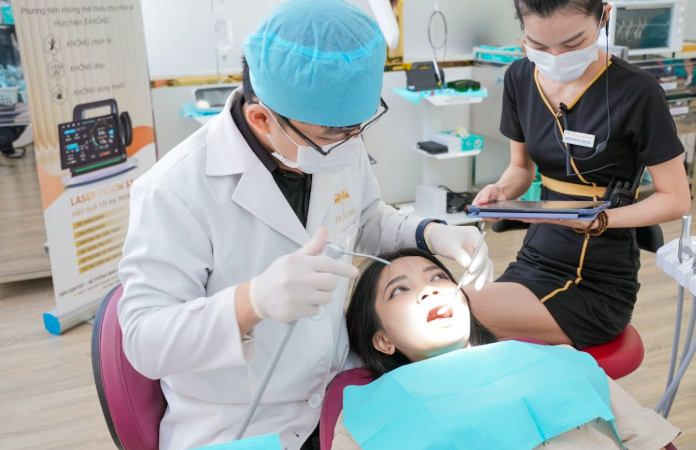Braces (orthodontics) use dental appliances (brackets, archwires, clear aligners) to arrange and move teeth into the desired position. This corrects misaligned teeth, overbites, underbites, crossbites, and other jaw-related issues. The goal is to restore perfect chewing function, create facial harmony, and prevent oral diseases.
Doctor Nguyen Minh, from Tam Dental Clinic, says many people make avoidable mistakes, leading to unsatisfactory results or even requiring treatment suspension to address complications.
Incorrect oral hygiene
Wearing orthodontic appliances like brackets and wires makes oral hygiene more challenging. According to Dr. Minh, improper care can trap food, promoting bacterial growth that leads to cavities, gingivitis, periodontitis, or gingival hyperplasia. These issues not only affect oral health but can also interrupt the braces process.
Patients with braces must follow their doctor's hygiene instructions. Brush at least three times daily with a specialized orthodontic toothbrush. After each meal, brush with a soft-bristled brush at a 45-degree angle around the brackets. Use interdental brushes, floss, or a water flosser to clean hard-to-reach areas. Brushing correctly is more important than the frequency.
Use interdental brushes, floss, and a water flosser for thorough cleaning. Rinsing with saline solution or alcohol-free mouthwash reduces infection risk. Brush after every meal with a soft-bristled toothbrush, carefully cleaning around the brackets at a 45-degree angle.
Improper chewing habits
Diet plays a crucial role in protecting orthodontic appliances. Eating hard foods (like crusty bread), chewy foods (like gummy candies), or very hot drinks can dislodge brackets, deform wires, and disrupt treatment. Uneven or insufficient chewing also affects orthodontic results.
Prioritize soft, easy-to-chew foods: porridge, soup, rice with vegetables, finely chopped meat and fish, and yogurt, especially initially. Cut food into small pieces to reduce pressure on teeth. Chew thoroughly and evenly on both sides of the jaw to distribute chewing force properly, aiding tooth movement.
Many people with braces avoid chewing, consuming only soft or liquid foods, leading to reduced jaw muscle activity, weight loss, and sunken cheeks. Therefore, chew frequently, eat a variety of foods (excluding tendons, cartilage, and bones), and avoid excessive dieting that can lead to a gaunt appearance.
 |
A doctor examines a patient's teeth. Photo: Loan Bui |
Choosing an unqualified doctor
A serious mistake is choosing an inexperienced doctor or believing in "cheap" advertisements. An unqualified orthodontist may create an unsuitable treatment plan, resulting in misaligned bites, teeth moving in the wrong direction, or damage to gums and roots. This leads to unsatisfactory results, prolonged treatment, and costly corrections.
Choose a reputable dental clinic with highly qualified and experienced doctors. Research thoroughly, consult those who have had successful orthodontic treatment, and verify the doctor's credentials for safety and effectiveness.
Missing appointments
Braces treatment is a long journey, lasting 1 to 3 years depending on the individual's teeth. Many miss regular checkups due to busy schedules or impatience from not seeing immediate results. Some experience initial pain or discomfort, leading to discouragement and treatment abandonment.
Strictly adhere to the doctor's appointment schedule. Each visit allows the doctor to adjust the force, ensuring proper tooth movement. Patience is key for optimal results. Discuss any difficulties with your doctor for timely support.
Not wearing interarch elastics or retainers
Interarch elastics are crucial in some orthodontic phases, adjusting the bite and aiding tooth movement. However, many find them uncomfortable and don't wear them consistently, prolonging treatment. Similarly, not wearing retainers as prescribed after bracket removal can cause teeth to shift back, negating the results.
Strictly follow the doctor's instructions regarding interarch elastics and retainers. Retainers maintain tooth position after bracket removal, especially during the first few months when teeth are still prone to shifting. Wearing retainers correctly and for the prescribed duration ensures lasting results.
Le Nga












